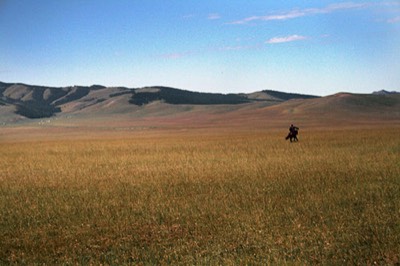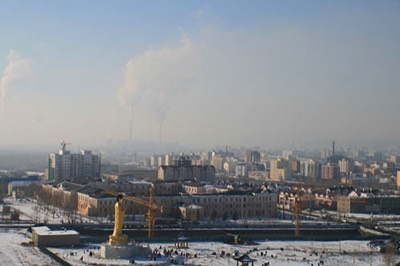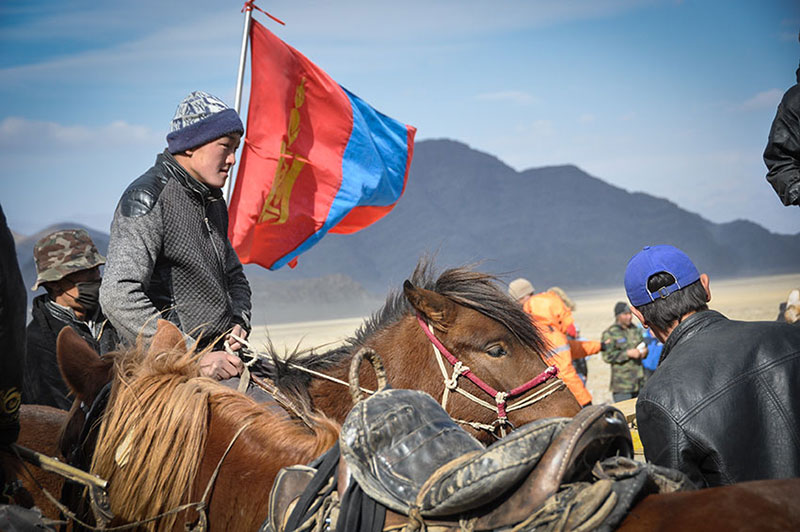The Land of the Eternal Blue Sky
Mongolia, the "Land of the Eternal Blue Sky", is clearly a fascinating country – a world of its own, unparalleled and unique. There aren't many places in the world with such a deep-rooted and yet lively nomadic culture, rich history and grandiose landscape. The sheer endless, lonely and windswept steppes and rolling green hills, the spectacular high-mountain ranges, as well as the beautiful, mysterious and deep Taiga in the far North are all affectionately adored and revered by the sparsely scattered but warm-hearted people who inhabit them together with their livestock. To most of these people particular mountains, springs and – most importantly – the "Eternal Blue Sky" are even sacred. They are not just features of the landscape – they are alive.
Nomadism: Life with the seasons

Ulaanbaatar: Mongolia's capital and antithesis

Before Mongolia's socialist revolution of 1920, "Red Hero" was known as either "Urga" or "Niislel Khüree" – "capital monastery". Then, under communist rule, the city was built up with wide avenues, Soviet architecture and at the time modern panel flat tower blocks all connected to a city-wide district heating system, planned to accommodate around 200,000 people and far less cars. However, with the fall of communism in 1990, and with the economically very difficult times that followed, especially after a row of deadly cold winters around the millennium killed a great percentage of the country's livestock and ruined the livelihood of ten thousands of families, the city began to grow massively and chaotically, in a way becoming the antithesis of what Mongolia is famous for: Overcrowded, rushed, and at times even claustrophobic. And yet still thousands of countryside people move to the city every year, lured here by the diverse promises of urban life.
To the countryside
As one leaves behind the last scattered gers and industrial buildings of Ulaanbaatar, the picture changes completely: The smog clouds gradually disappear, the wide steppe-landscape opens up, traffic radically decreases and in fact after a while the only disturbances and "traffic jams" on the road will be created by herds of cows, sheep and goats claiming the right of way. Infrastructure fades out with every kilometer away from the capital. In fact the only bigger concentrations of settled life will be come across in form of the few much smaller province-capitals and around the widely scattered, village-like "sum-centres" that serve as the administrational infrastructure for all rural life, settled and nomadic alike. With very few exceptions, roads are in a completely desolate state or simply not existent. Once far away from the urban world, expensive Western and Japanese Jeeps become an increasingly rare sight. Instead, this is still the undisputed domain of the old, unpretentious and absolutely no-frills Russian UAZ Jeeps and minibuses. Usually packed with passengers up to under the roof, these hard-working iron beasts of burden deliver goods and people to the farthest villages of the country as well as to nomadic camps even. Out here, you'll see camels grazing, children playing in front of their families' gers and horsemen herding their flocks of sheep and goats. And occasionally you might see two guys transporting a living, bleating goat on a Chinese motorbike. Time becomes irrelevant, the concept of hurry ridiculous. "Tavtai Morilno uu" – Welcome. Welcome to this fascinating country in the heart of Asia that has kept its nomadic heritage alive until this very day.

Company information
Copyright © Siesta Oppi Kanu Shop GmbH, Switzerland. All rights reserved.
Siesta Oppi Kanu Shop GmbH
Sensebrücke 13a
CH-3176 Neuenegg
Switzerland
Commercial register number: CH-217.0.640.961-3
VAT number: CHE 108.627.887
Siesta Oppi Kanu Shop GmbH
Sensebrücke 13a
CH-3176 Neuenegg
Switzerland
Commercial register number: CH-217.0.640.961-3
VAT number: CHE 108.627.887
contact us
IN SWITZERLAND:
Telephone: +41 (0)31 741 91 92
Fax: +41 (0)31 741 91 09
Email: info@kanuladen.ch
IN MONGOLIA:
Telephone: (+976) 99086004
Email: info@fatyaktravel.com
Telephone: +41 (0)31 741 91 92
Fax: +41 (0)31 741 91 09
Email: info@kanuladen.ch
IN MONGOLIA:
Telephone: (+976) 99086004
Email: info@fatyaktravel.com
Social Media
Visit us on Facebook: Please click on the Social Button in the right bottom corner